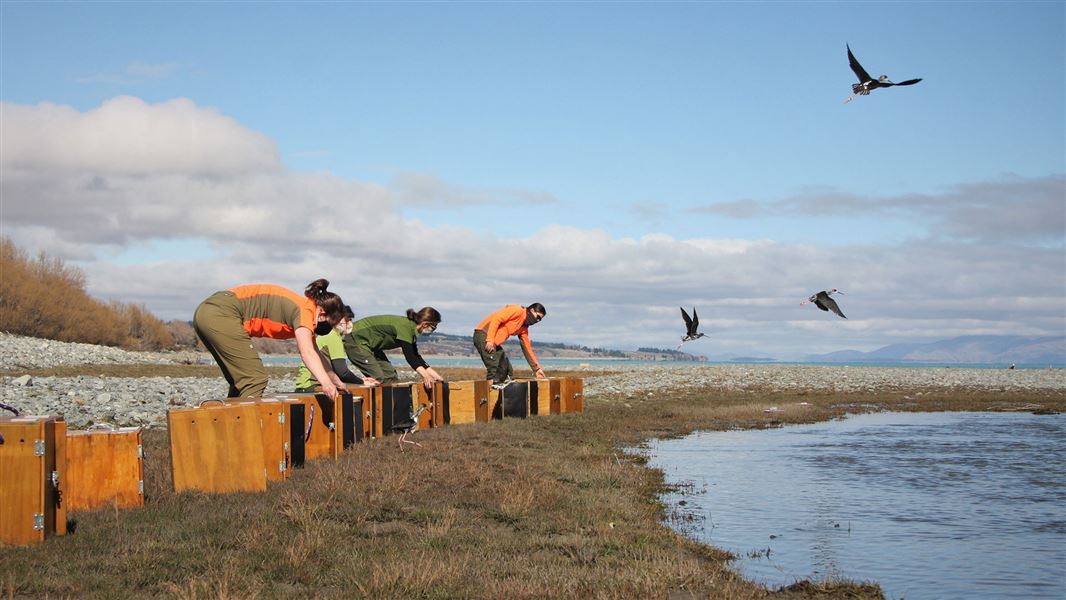
Introduction
One hundred and fifty young kakī/black stilt have been released into Te Manahuna/Mackenzie Basin – a significant boost to the population of the critically endangered wading bird.Date: 02 September 2021
The kakī were reared in captivity at the Department of Conservation’s (DOC) Twizel facility and the Isaac Conservation and Wildlife Trust, from eggs collected from both wild and captive breeding pairs, as part of the Kakī Recovery Programme.
Two releases went ahead before the current COVID-19 lockdown came into effect. DOC staff were given special permission to go ahead with a third release on Monday, while the country was at Alert Level 4, because of serious welfare risks to the kakī.
DOC Kakī Team Leader Claudia Mischler says the kakī had reached a stage where they had become aggressive in the limited space of the brooding facility, which was causing stress that could have had serious health implications, and they needed to be released as soon as possible.
“Like the rest of New Zealand, DOC staff are staying home to stop the spread of COVID-19 and save lives, so our field work is currently on hold.
“In this case, the decision was made to go ahead with the kakī release because the risk to staff and the community was low and a release needed to take place for the welfare of these special birds, which are important to the future of the species.”
Fortunately for the kakī, five key DOC staff were able to do the work in two small bubbles that remained socially distanced throughout the release. Some of the staff were already in a bubble together to care for the kakī in captivity. Masks were also worn and other precautions were taken, such as regular use of hand sanitiser.
“After a great year of raising chicks, it was rewarding to see so many birds released back into the wild to add to the growing population,” Claudia Mischler says.
“This is the second-best year on record for breeding in the wild. 175 eggs were collected this season, while another 66 were left to hatch in their nests.”
Claudia Mischler says 39 wild breeding pairs of kakī were identified this season, the most on record.
“This season, 54% of the wild breeding pairs laid eggs on private land. The success of the programme relies on support from landowners, who have really got behind efforts to protect these special birds and often let us know where they have been setting up nests.”
Many of the landowners in the Mackenzie Basin are partners in conservation project Te Manahuna Aoraki, which has extended trapping across 80% of the kakī range.
Braemar Station owner Hamish Mackenzie says: “Being involved in Te Manahuna Aoraki has meant we are working together as partners, and we are really enjoying seeing more kakī around.
“To be able to say you have the rarest wading bird in the world living and breeding on your property is really exciting."
Te Manahuna Aoraki Project Manager Simone Smits says landowners are helping to protect kakī by allowing access for trapping, ensuring there is healthy wetland habitat and alerting DOC rangers when they spot nesting birds.
Kakī are vulnerable to mammalian predators, so an extensive trapping network is a key part of the efforts to ensure the species survival.
Since 2018, Te Manahuna Aoraki has installed more than 2000 traps in the Tasman, Cass, Godley and Macauley river valleys.
The extra traps added to DOC and Project River Recovery’s (Meridian Energy and Genesis Energy) existing network in the Tasman River increasing the trapping network from 26,000ha, to more than 60,000 ha. These trapping networks are on both public land, and private land.
Background information
Kakī, a taonga species for Ngāi Tahu, are largely found in braided riverbeds, side streams, swamps and tarns in Te Manahuna/Mackenzie Basin. Most riverbed birds migrate to coastal areas in winter, but kakī usually remain in the Mackenzie Basin despite parts of their habitat freezing over.
Kakī have been intensively managed since 1981 when their population declined to a low of just 23 birds. DOC's captive breeding centre near Twizel plays an important role in the Kakī Recovery Programme.
This year, 150 young kakī were released into the Godley and Tasman riverbeds in three releases in August. The birds were raised at DOC’s brooding facility near Twizel and at the Isaac Conservation and Wildlife Trust in Christchurch.
There are currently about 170 adult kakī in the wild. Juveniles released this year will not be included in population counts until they reach breeding age in 2022.
DOC works with a range of partners to support kakī, including The Isaac Conservation and Wildlife Trust, which raises birds in its Christchurch aviary. The kakī programme has received funding support from partners such as Re:wild, and Meridian Energy and Genesis Energy who both fund Project River Recovery.
Contact
For media enquiries contact:
Email: media@doc.govt.nz